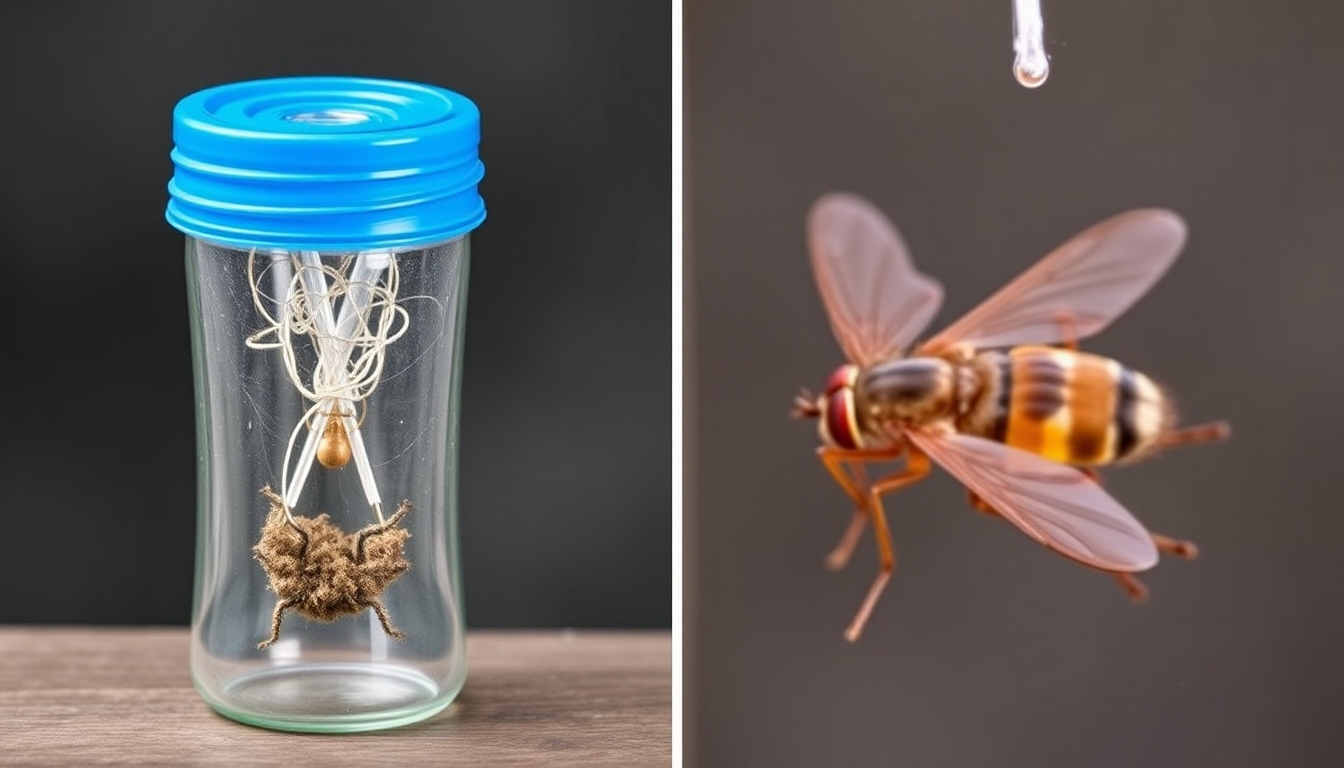Are you tired of pesky flies invading your space? Look no further! In this article, we will guide you through the world of DIY flytraps, offering effective and affordable solutions to keep those buzzing nuisances at bay. Say goodbye to chemical-laden sprays and expensive traps – with a little creativity and minimal effort, you can create your own flytrap using everyday household items. Whether you are dealing with fruit flies in the kitchen or flies in the garden, our informative guide will equip you with the knowledge to tackle the issue head-on. So, roll up your sleeves and get ready to bid farewell to those bothersome flies!
Understanding the Fly Problem
Before jumping into the world of DIY flytraps, it’s important to understand the nature of the problem you’re dealing with. Flies are not only annoying but can also pose health risks as they carry diseases and bacteria from one place to another. Identifying the type of flies you are dealing with can help determine the most effective trap for your situation.
1. Fruit Flies
Fruit flies are small, flying insects that are commonly found around ripe or decaying fruits, vegetables, and fermented liquids. These tiny pests reproduce rapidly and can be a nuisance in your kitchen or pantry.
2. House Flies
House flies are larger flies that are attracted to food, garbage, and feces. They are known for buzzing around homes and can quickly multiply if not addressed.
3. Cluster Flies
Cluster flies are often mistaken for house flies but have a slower, more sluggish behavior. They tend to cluster in large numbers on windows and are commonly found in attics and wall voids. These flies are more prevalent during the cooler months.
4. Drain Flies
Drain flies, also known as moth flies, breed in the organic matter that accumulates within drains and pipes. They are small, fuzzy insects with a characteristic fluttering flight pattern.
Understanding the specific fly species you are dealing with will help you devise the most effective DIY flytrap strategy. Now that you have a better understanding of the different types of flies, let’s move on to exploring various DIY flytrap options to tackle your fly problem head-on.
DIY Flytraps: Effective and Affordable Solutions
When it comes to dealing with flies, you don’t always have to rely on store-bought traps or harmful chemicals. With a little creativity and some basic household items, you can create your own DIY flytraps that are not only effective but also cost-effective. Let’s explore some simple yet efficient flytrap options:
1. Vinegar Flytrap
Vinegar is a powerful fly attractant due to its strong scent. To create a vinegar flytrap, simply pour some apple cider vinegar or white vinegar into a jar or bowl and cover it securely with plastic wrap. Poke a few small holes in the plastic wrap to allow flies to enter. The flies will be lured by the vinegar scent, enter the trap, and get trapped inside.
2. Sticky Paper Trap
A sticky paper trap is an excellent solution for catching flies in larger areas like kitchens or garages. You can make your own sticky paper by coating a piece of cardboard or heavy paper with a sticky substance like honey or syrup. Hang the sticky paper in areas where flies are frequently seen. The flies will be attracted to the sweet scent and get stuck on the paper.
3. Bottle Trap
A bottle trap is a simple yet effective way to catch flies. Cut off the top third of a plastic bottle and invert it, placing it back into the remaining bottom portion. Fill the bottom of the bottle with a mixture of sugar water, vinegar, or ripe fruit. Flies will be attracted to the scent, enter the bottle through the opening, and find it difficult to escape.
4. Carnivorous Plant Flytrap
If you’re up for a more unique approach, consider growing carnivorous plants like Venus flytraps or pitcher plants. These plants have specialized leaves that can trap and digest insects. By placing them strategically around your home or garden, you can naturally control fly populations.
These DIY flytrap options are just the tip of the iceberg. With a quick search online, you’ll find countless other creative ideas to combat those pesky flies. Experiment with different traps and see which ones work best for your specific fly problem. Remember, prevention is key, so maintaining cleanliness and proper waste management will also help reduce fly populations in the long run. Stay tuned for the next section where we’ll dive into additional tips and tricks to keep flies at bay.
Tips and Tricks to Prevent Fly Infestations
While DIY flytraps can help control existing fly populations, prevention is always better than cure. Here are some additional tips and tricks to help prevent fly infestations in your home:
1. Maintain Cleanliness
Flies are attracted to food sources and filth. Regularly clean your kitchen, dining areas, and garbage cans to remove any food residues or spills that may attract flies. Keep your trash cans tightly sealed and dispose of garbage regularly to avoid creating a breeding ground for flies.
2. Cover Food and Store Properly
Flies are notorious for landing on uncovered food and spreading bacteria. Keep your food covered, whether it’s inside the house or outside during picnics or barbecues. Use mesh food covers or tightly sealed containers to protect your meals from fly contamination.
3. Seal Entry Points
Inspect your doors, windows, and screens for any gaps or holes that flies can use to enter your home. Seal these entry points with weatherstripping or repair damaged screens to prevent flies from finding their way indoors.
4. Use Natural Repellents
Consider using natural fly repellents to deter flies from entering your space. Essential oils like citronella, lavender, or eucalyptus can be mixed with water and sprayed in fly-prone areas. You can also place fresh herbs like basil, mint, or rosemary near doorways and windows to discourage flies.
5. Regularly Clean Drains
As mentioned earlier, drain flies can be a common nuisance. Keep your drains clean by regularly flushing them with boiling water or using a mixture of vinegar and baking soda to remove any organic matter that may attract these flies.
By implementing these preventive measures alongside your DIY flytraps, you can significantly reduce the chances of fly infestations in your home. Remember, consistency is key, so make these practices a part of your routine to maintain a fly-free environment. With a little effort and some clever strategies, you can keep those buzzing pests at bay and enjoy a fly-free living space.
Conclusion: Fly-Free Living Made Easy
Dealing with flies can be frustrating, but with the right knowledge and tools, you can regain control of your living space without relying on expensive commercial solutions. DIY flytraps offer effective and affordable alternatives that can help you combat fly infestations.
From vinegar flytraps to sticky paper traps, bottle traps, and even carnivorous plants, there is a wide range of options to choose from. Experiment with different methods to find the one that works best for your specific fly problem.
Remember, prevention is key. By maintaining cleanliness, covering food, sealing entry points, using natural repellents, and regularly cleaning drains, you can significantly reduce the chances of fly infestations in your home.
So, say goodbye to those pesky flies and embrace a fly-free living environment. With a little effort and ingenuity, you can enjoy a comfortable space without the constant buzzing and annoyance. Implement these DIY flytrap techniques and preventive measures, and reclaim your home from those unwanted winged visitors.
With these effective DIY flytraps and preventive strategies, you can now tackle fly problems head-on, all while staying within budget and minimizing the use of harmful chemicals. So, roll up your sleeves, get creative, and enjoy a fly-free living space!
Disclaimer: Professional Help
While DIY flytraps and preventive measures can be effective in managing fly problems, there may be instances where professional help is necessary. If you find yourself dealing with a severe or persistent fly infestation that DIY methods fail to control, it is advisable to seek assistance from pest control professionals.
Professional exterminators have the expertise, experience, and access to advanced tools and techniques to effectively eliminate fly infestations. They can assess the extent of the problem, identify the underlying causes, and provide targeted solutions to address the issue at its source.
Additionally, if you have concerns about the presence of flies in sensitive areas such as food establishments, healthcare facilities, or commercial spaces, it is crucial to consult with professionals who specialize in pest management for these specific industries.
Remember, while DIY approaches can be successful in many cases, it is important to prioritize your safety and wellbeing. If you are unsure or uncomfortable dealing with a fly infestation on your own, it is always best to consult with professionals who can handle the situation effectively and safely.
By combining the knowledge and expertise of professionals with the DIY techniques discussed in this article, you can ensure a comprehensive approach to fly management, giving you peace of mind and a fly-free environment.
Final Thoughts: Enjoy a Fly-Free Space
Dealing with flies can be a nuisance, but with the right knowledge and tools, you can take control of your living space and enjoy a fly-free environment. DIY flytraps offer practical and cost-effective solutions, allowing you to tackle fly infestations on your own terms.
Remember to identify the type of flies you are dealing with to select the most suitable trap. Whether it’s fruit flies, house flies, cluster flies, or drain flies, there is a DIY trap that can effectively target these pests.
In addition to DIY flytraps, implementing preventive measures is crucial in maintaining a fly-free space. By practicing cleanliness, proper food storage, sealing entry points, using natural repellents, and regularly cleaning drains, you can significantly reduce the chances of fly infestations.
However, it’s important to acknowledge that severe or persistent fly infestations may require professional assistance. Pest control professionals have the expertise and tools to address complex fly problems effectively.
By combining DIY methods with professional help when needed, you can ensure a comprehensive approach to fly management. Embrace a fly-free living space and enjoy the comfort and peace of mind that comes with it.
So, take charge of your environment, get creative with DIY flytraps, and implement preventive strategies. Bid farewell to those bothersome flies and reclaim your space!
Additional Resources for Fly Control
If you’re interested in further exploring the world of fly control, there are numerous resources available that can provide you with additional information and guidance. Here are a few recommended resources to expand your knowledge:
1. Online Forums and Communities
Joining online forums and communities focused on pest control can be a valuable resource. Connect with like-minded individuals who have dealt with fly problems and share their experiences and tips. You can ask questions, seek advice, and learn from the collective knowledge of the community.
2. Books and Publications
There are several books and publications available that delve into the topic of fly control. These resources often provide comprehensive information on different fly species, their habits, and effective control methods. Visit your local library or search online for titles that can help you gain a deeper understanding of fly management.
3. Pest Control Websites
Many reputable pest control companies and organizations have informative websites that offer tips, guides, and resources for fly control. These websites often provide detailed information on various fly species, prevention techniques, and recommended products. Explore these websites for valuable insights and practical advice.
4. Extension Services
Extension services provided by universities and agricultural institutions can be excellent sources of information on fly control. They offer research-based advice and resources tailored to specific regions and environments. Check if your local university or agricultural extension service has any publications or online resources available.
By utilizing these additional resources, you can expand your knowledge and stay informed about the latest developments in fly control. Remember, the more you know, the better equipped you will be to tackle fly problems effectively and maintain a fly-free environment.
Enjoy a Fly-Free Environment
With the information and strategies provided in this article, you are now equipped to take control of fly problems and create a fly-free environment. DIY flytraps offer effective and affordable solutions, while preventive measures help in reducing fly infestations.
Remember to identify the type of flies you are dealing with and choose the appropriate trap accordingly. Fruit flies, house flies, cluster flies, and drain flies all require different approaches for effective control.
Implement cleanliness practices, cover food, seal entry points, use natural repellents, and regularly clean drains to prevent fly infestations. These preventive measures, when combined with DIY flytraps, can significantly reduce the presence of flies in your living space.
However, if fly problems persist or become severe, it may be necessary to seek professional assistance. Pest control professionals have the expertise and tools to handle complex infestations and provide targeted solutions.
Explore additional resources such as online forums, books, pest control websites, and extension services to expand your knowledge and stay informed on the latest fly control techniques.
By implementing the strategies discussed in this article, you can enjoy a fly-free environment, free from the annoyance and potential health risks associated with flies. Take charge of your space, implement effective fly control measures, and enjoy a comfortable and fly-free living area.
In conclusion, dealing with flies can be a frustrating and bothersome experience. However, with the right knowledge and tools, you can effectively control fly infestations and create a fly-free environment. DIY flytraps offer practical and cost-effective solutions, allowing you to tackle fly problems on your own terms. Additionally, implementing preventive measures such as cleanliness, proper food storage, and sealing entry points can significantly reduce the chances of fly infestations. While DIY methods can be successful in many cases, severe or persistent infestations may require professional assistance. Pest control professionals have the expertise and tools to address complex fly problems effectively. By combining DIY approaches with professional help when needed, you can ensure a comprehensive approach to fly management. Embrace a fly-free living space and enjoy the comfort and peace of mind that comes with it. So, say goodbye to those pesky flies and reclaim your space!






